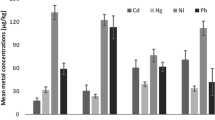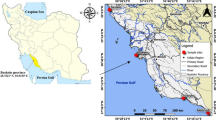Abstract
Colombia is a fish exporter and consumer country because of its geographical location. Since 2012, imported fish have become a more economical option than domestic species due to free trade agreements. Concentrations of Pb, Cd, and Zn were evaluated in three imported and highly commercialized fish species in a city on the Caribbean coast of Colombia: Prochilodus lineatus, Prochilodus reticulatus, and Pangasianodon hypophthalmus, plus one brand of canned tuna and one brand of sardines. The canned species showed the highest values for Pb, Cd, and Zn; canned tuna (oil-packed) contained 0.189 ± 0.047 mg/kg Pb and 238.93 ± 76.43 mg/kg Zn, while canned sardines contained 0.111 ± 0.099 mg/kg Cd, suggesting a relationship between the canning process and the metal concentrations. The estimated daily intake (EDI) and hazard quotient (HQ) suggested that there is no risk for consumer health in the short term, but the presence of these heavy metals certainly should be a concern in the long term because of the bioaccumulation phenomenon due to the high intake of these fish species in this coastal and tourist community. It is recommended that continuous monitoring of heavy metal concentrations take place to protect communities in a local and global context.




Similar content being viewed by others
References
Swanson D, Block R, Mousa SA (2012) Omega-3 fatty acids EPA and DHA: health benefits throughout life. Adv Nutr 3(1):1–7
FAO (2016) FAO fisheries and aquaculture department. Utilization and trade. Topics fact sheets. https://www.fao.org/fishery/utilization_trade/en. Accessed April 2017
Squadrone S, Burioli E, Monaco G, Koya MK, Prearo M, Gennero S, Dominici A, Abete MC (2016) Human exposure to metals due to consumption of fish from an artificial lake basin close to an active mining area in Katanga (D.R. Congo). Sci Total Environ 568:679–684
Dipak P (2017) Research on heavy metal pollution of river ganga: a review. Ann Agrarian Sci 15(2):278–286
Tao Y, Yuan Z, Xiaona H, Wei M (2012) Distribution and bioaccumulation of heavy metals in aquatic organisms of different trophic levels and potential health risk assessment from Taihu lake, China. Ecotoxicol Environ Saf 81:55–64
Dhanakumar S, Solaraj G, Mohanraj R (2015) Heavy metal partitioning in sediments and bioaccumulation in commercial fish species of three major reservoirs of river Cauvery delta region, India. Ecotoxicol Environ 113:145–151
Zhang L, Shi Z, Jiang Z, Zhang J, Wang F, Huang X (2015) Distribution and bioaccumulation of heavy metals in marine organisms in east and west Guangdong coastal regions, South China. Mar Pollut Bull 101(2):930–937
Yi Y, Yang Z, Zhang S (2011) Ecological risk assessment of heavy metals in sediment and human health risk assessment of heavy metals in fishes in the middle and lower reaches of the Yangtze River basin. Environ Pollut 159(10):2575–2585
Zhao S, Feng C, Quan W, Chen X, Niu J, Shen Z (2012) Role of living environments in the accumulation characteristics of heavy metals in fishes and crabs in the Yangtze River Estuary, China. Mar Pollut Bull 64(6):1163–1171
Kalantzi I, Black KD, Pergantis SA, Shimmield TM, Papageorgiou N, Sevastou K, Karakassis I (2013) Metals and other elements in tissues of wild fish from fish farms and comparison with farmed species in site with oxic and anoxic sediments. Food Chem 141(2):680–694
Kwok CK, Liang Y, Wang H, Dong YH, Leung SY, Wong MH (2014) Bioaccumulation of heavy metals in fish and ardeid at Pearl River Estuary, China. Ecotoxicol Environ Saf 106:62–67
Jayaprakash M, Kumar RS, Giridharan L, Sujitha SB, Sarkar SK, Jonathan MP (2015) Bioaccumulation of metals in fish species from water and sediments in macrotidal Ennore creek, Chennai, SE coast of India: a metropolitan city effect. Ecotoxicol Environ Saf 120:243–255
Fuentes-Gandara F, Pinedo-Hernández J, Marrugo-Negrete J (2018) Metales pesados en especies ícticas de la ciénaga de Mallorquín, Colombia. Espacios 39(3):1–12
Monroy M, Maceda-Veiga A, de Sostoa A (2014) Metal concentration in water, sediment and four fish species from Lake Titicaca reveals a large-scale environmental concern. Sci Total Environ 487:233–244
Leung HM, Leung AO, Wang HS, Ma KK, Liang Y et al (2014) Assessment of heavy metals/metalloid (As, Pb, Cd, Ni, Zn, Cr, Cu, Mn) concentrations in edible fish species tissue in the Pearl River Delta (PRD), China. Mar Pollut Bull 78(1–2):235–245
Fuentes-Gandara F, Pinedo-Hernández J, Marrugo-Negrete J, Díez S (2018) Human health impacts of exposure to metals through extreme consumption of fish from the Colombian Caribbean Sea. Environ Geochem Health 40(1):229–242
Fuentes-Gandara F, Herrera-Herrera C, Pinedo-Hernández J, Marrugo-Negrete J, Díez S (2018) Assessment of human health risk associated with methylmercury in the imported fish marketed in the Caribbean. Environ Res 165:324–329
Caussy D, Gochfeld M, Gurzau E, Neagu C, Ruedel H (2003) Lessons from case studies of metals: investigating exposure, bioavailability, and risk. Ecotoxicol Environ Saf 56(1):45–51
Akoto O, Bismark Eshun F, Darko G, Adei E (2014) Concentrations and health risk assessments of heavy metals in fish from the Fosu lagoon. Int J Environ Res 8(2):403–410
Gu YG, Lin Q, Yu ZL, Wang XN, Ke CL, Ning JJ (2015) Speciation and risk of heavy metals in sediments and human health implications of heavy metals in edible nekton in Beibu Gulf, China: a case of study of Qinzhou Bay. Mar Pollut Bull 101(2):852–859
Yao-Wen Q (2015) Bioaccumulation of heavy metals both in wild and mariculture food chains in Daya Bay, South China. Estuar Coast Shelf Sci 163:7–14
MADR (2013). Ministry of Agriculture and Rural Development of Colombia. http://www.aunap.gov.co/wp-content/uploads/2017/06/Politica_Integral_de_Pesca_MADR_FAO_julio_de_2015.pdf. Accessed April 2017
FAO (2015) Colombia. “Pesca en cifras 2014”. Food and Agriculture Organization, Bogotá ISBN 978-92-5-308829-4
Salazar-Lugo R (2009) Estado de conocimiento de las concentraciones de cadmio, mercurio y plomo en organismos acuáticos de Venezuela. REDVET - Electron J Vet 10(11):1–15
Schenone N, Aviglianoa E, Goessler W, Fernández Cirelli A (2014) Toxic metals, trace and major elements determined by ICPMS in tissues of Parapimelodus valenciennis and Prochilodus lineatus from Chascomus Lake, Argentina. Microchem J 112:127–131
Srivastava S, Verma P, Verma AK, Singh AK (2014) Assessment for possible metal contamination and human health risk of pangasianodon hypoththalmus. Int J fish Aquat Stud 1(5):176–181
Okyere H, Voegborlo RB, Agorku SE (2015) Human exposure to mercury, lead and cadmium through consumption of canned mackerel, tuna, pilchard and sardine. Food Chem 179:331–335
UNEP/IAEA/IOC (1990) Reference Methods and Materials: A programme of support for regional and globa marine pollution assessments. Reference Methods for Marine Pollution Studies, RSRM 11
FAO/WHO (2017) Codex committee on food additives and contaminants. The Hague, Netherlands Adopted in 1995 Revised in 1997, 2006, 2008, 2009 Amended in 2010, 2012, 2013, 2014, 2015, 2016, 2017. http://www.fao.org/fao-who-codexalimentarius/sh-proxy/fr/?lnk=1&url=https%253A%252F%252Fworkspace.fao.org%252Fsites%252Fcodex%252FStandards%252FCODEX%2BSTAN%2B193-1995%252FCXS_193e.pdf. Acceded Sept 2016
USEPA (2000) Guidance for assessing chemical contaminant data for use in fish advisories. Risk assessment and fish consumption limits, EPA 823-B-00-008, vol 2, 3rd edn. USEPA Office of Water, Washington, DC, p 383 https://www.epa.gov/sites/production/files/2015-06/documents/volume2.pdf
Usero J, González-Regalado E, Gracia I (1997) Trace elements in bivalve molluscs Ruditapes decussatus and Ruditapes philippinarum from the Atlantic coast of southern Spain. Environ Int 23(3):291–298
European Union Commission (2006) Health and food safety. Regulation (EC) No 1881/2006. http://eur-lex.europa.eu/legal-content/ES/TXT/PDF/?uri=CELEX:32006R1881andfrom=ES. Acceded Sept 2016
MHSP (2012). Resolution no. 122, the Colombian Ministry of Health and social protection. Bogotá – Colombia, p. 10
Rosenberg CE, Carpinetti BN, Apartín C (2001) Contenido de metales pesados en tejidos de sábalos (prochilodus lineatus) del río Pilcomayo, Misión La Paz, Provincia de Salta. Natura Neotropicalis 32(2):141–145
Quezada AOR, Corcuy NA, Moreno JR (2005) Niveles De Plomo En Músculo De Sábalo (P. lineatus y P. nigricans) Provenientes Del Rio Pilcomayo y Rio Grande. Dissertation, Facultad de Ciencias Veterinarias, UAGRM
Khansari FE, Ghazi-Khansari M, Abdollahi M (2005) Heavy metals content of canned tuna fish. Food Chem 93(2):293–296
Tuzen M, Soylak M (2007) Determination of trace metals in canned fish marketed in Turkey. Food Chem 101(4):1378–1382
Tarley CRT, Coltro WKT, Matsushita M, de Souza NE (2001) Characteristic levels of some heavy metals from Brazilian canned sardines (Sardinella brasiliensis). J Food Compos Anal 14(6):611–617
Shiber JG (2011) Arsenic, cadmium, lead and mercury in canned sardines commercially available in eastern Kentucky, USA. Mar Pollut Bull 62(1):66–72
Yılmaz AB, Sangün MK, Yağlıoğlu D, Turan C (2010) Metals (major, essential to non-essential) composition of the different tissues of three demersal fish species from Iskenderun Bay, Turkey. Food Chem 123(2):410–415
Araújo CVM, Cedeño-Macías LA (2016) Heavy metals in yellowfin tuna (Thunnus albacares) and common dolphinfish (Coryphaena hippurus) landed on the Ecuadorian coast. Sci Total Environ 541:149–154
ATSDR (2015) Agency for Toxic Substances and Disease Registry. http://www.atsdr.cdc.gov/ToxProfiles/TP.asp?id=302andtid=54
USEPA (2016) Environmental Protection Agency, integrated risk information system. CRC. http://www.epa.gov/iris/. Accessed 23 Nov 2017
JECFA (2015) Joint food and agriculture organization/world health organization expert committee on food additives. Summary and conclusions of the meetings of the joint FAO/WHO Expert Committee on food additives. http://apps.who.int/food-additives-contaminants-jecfa-database/Search.aspx. Accessed 23 Nov 2017
Buculei A, Amariel S, Oroian M et al (2014) Metals migration between product and metallic package in canned meat. LWT Food Sci Technol 58(2):364–374
Li Y, McCrory DF, Powell JM, Saam H, Jackson-Smith D (2005) A survey of selected heavy metal concentrations in Wisconsin dairy feeds. J Dairy Sci 88(8):2911–2922
Hu H (2002) Human health and heavy metals exposure. In: McCally M (Ed) Chapter 4, Life Support: The Environment and Human Health. MIT Press. http://applied-bioresearch.com/wp-content/uploads/2015/03/heavy-metals1.pdf. Accessed 20 Nov 2017
Castro-González MI, Méndez-Armenta M (2008) Heavy metals: implications associated to fish consumption. Environ Toxicol Pharmacol 26(3):263–271
Acknowledgments
The authors are grateful to the Universidad de la Costa for financial support and to the Laboratory of Toxicology and Environmental Management of the Universidad de Córdoba (project code FCB0114/2014) for their collaboration in the analysis of the heavy metal concentrations in the studied species. We appreciate the anonymous reviewers for their many insightful comments and suggestions to improve the quality of the manuscript.
Author information
Authors and Affiliations
Corresponding author
Ethics declarations
Conflict of Interest
The authors declare that they have no conflicts of interest.
Rights and permissions
About this article
Cite this article
Herrera-Herrera, C., Fuentes-Gandara, F., Zambrano-Arévalo, A. et al. Health Risks Associated with Heavy Metals in Imported Fish in a Coastal City in Colombia. Biol Trace Elem Res 190, 526–534 (2019). https://doi.org/10.1007/s12011-018-1561-1
Received:
Accepted:
Published:
Issue Date:
DOI: https://doi.org/10.1007/s12011-018-1561-1




